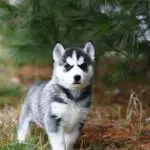Doberman pinscher puppy and dog information
The Doberman Pinscher can live in an apartment but will need frequent vigorous exercise or she may become hyper. A properly fenced in yard, suburban area or farm is best. She is not an outside dog in cold climates as she is cold sensitive. She should be extensively socialized as a puppy or she may become over protective. She makes a fine natural watch dog and guard dog. She is highly intelligent and trains easily. She can tolerate older children but be careful. As a reminder, never leave a young child unsupervised with a puppy or dog. She craves being physically close to her human family. She may require an experienced handler and she may fight with other dogs.
*Approximate Adult Size. The approximate adult size (two years old or older) of the male Doberman Pinscher is 26 to 28 inches to the withers (highest point of the shoulder) and 66 to 88 pounds. The female ranges from 24 to 26 inches to the withers and 66 to 80 pounds.
*Special Health Considerations. Most dog breeds have certain inherited health problems associated with that specific breed and the Doberman Pinscher is no exception. Be on the look out for bloat (Gastric Dilation-Volvulus, the second leading killer of dogs, can kill within the hour, this space is too limited for a complete explanation but you should read up on this). Feeding more then once a day and avoiding exercise right after meals may help guard against bloat, canine hip dysplasia (genetic based looseness in the hip joint that can lead to arthritis pain and lameness), Von Willebrands disease (a problem with blood clotting), skin problems, liver disease, fatty tumors, Wobbler Disease and hypothyroidism (sluggish thyroid gland which can result in weight gain). This disease list is an informative guideline only. Other diseases may also be significant threats, please contact your veterinarian for a complete list.
She should visit the veterinarian several times in the first year for shots, boosters and check up. Then, as an adult, she should visit the veterinarian yearly for shots and check up. As she gets older, six years and on, she should visit the veterinarian twice a year for check ups and shots. Remember; avoid feeding your dog sweets.
*Grooming. The Doberman Pinscher has a short, close lying fine coat that sheds average. She should be brushed regularly. Brushing will help her maintain a clean and healthy coat and help you keep a closer eye on her health and strengthen your emotional bond with her.
Her teeth should be brushed at least twice a week with toothpaste and toothbrush designed for dogs. Brushing removes the accumulation of plaque and tartar which can cause cavities (rarely) and periodontal disease. Dog periodontal disease can lead to pain, loss of teeth, bad breath and other serious disease.
Her toenails may need to be examined for growth and clipped regularly. The toenails of the rear feet grow slower than the toenails of the front feet. Generally a guillotine type trimmer is the best for this chore and competent instructions to accomplish this can be found on the net.
*Life Span. The Doberman Pinscher can live between 12 and 15 years with proper nutrition, medical care and excellent living conditions.
*History. The Doberman Pinscher comes from Germany in 1890 or so as a mix of the Rottweiler, Tan Terrier, short haired shepherd and the smooth-haired Pinscher. They were named after Louis Dobermann, a tax collector who was looking for a companion and protector to accompany him on his rounds. They were first registered by the American Kennel Association in 1908.
Some Registries: *Doberman Pinscher Club of America *UKC United Kennel Club *NKC National Kennel Club *CKC Continental Kennel Club *APRI Americas Pet Registry Inc. *AKC American Kennel Club *FCI Federation Cynologique Internationale *NZKC New Zealand Kennel Club *KCGB = Kennel Club of Great Britain *ANKC = Australian National Kennel Club *ACR = American Canine Registry
Litter Size: 3 to 10 Doberman Pinscher puppies
Category: Working
Terms To Describe:Alert, intelligent, protective, fearless, elegant, sleek, aristocratic, quick, muscular, powerful, great speed, alert, loyal
*SPECIAL GOOD POINTS Good watchdog. Good Guard dog. Good jogger dog. Easy to train. Highly intelligent.
*SPECIAL BAD POINTS She will do better with a dominant owner. Not a choice for small children. Depending upon breeding, can have temperament problems. Males can fight with other dogs. Needs vigorous exercise daily. Can be hyperactive. Needs to be socialized when young. Can be over protective. Cold sensitive. Not an outside dog in cold climates. May be a one person dog.
*Other Names Known By: Dobe, Dobermann
*Every dog is an individual so not everything in this information may be correct for your dog. This information is meant as a good faith guideline only.


